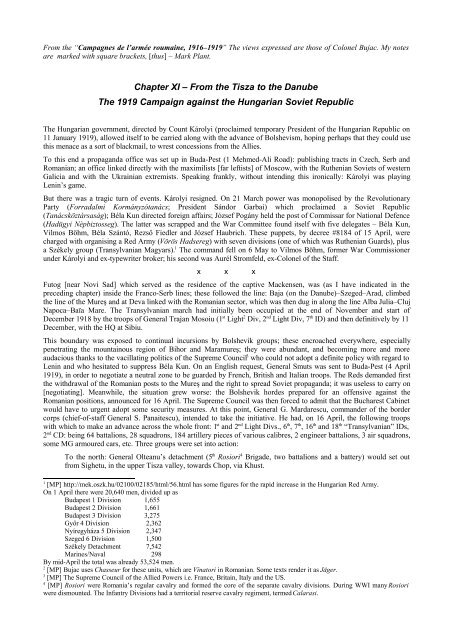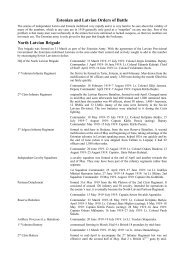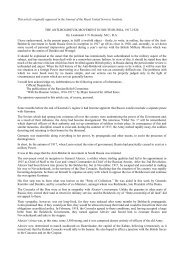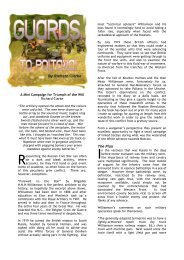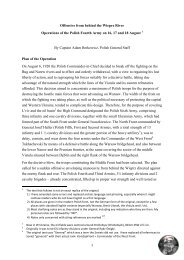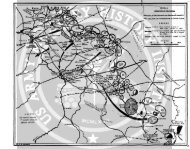Bujac Chapter on Romanian Invasion of Hungary 1919 - Pygmy Wars
Bujac Chapter on Romanian Invasion of Hungary 1919 - Pygmy Wars
Bujac Chapter on Romanian Invasion of Hungary 1919 - Pygmy Wars
Create successful ePaper yourself
Turn your PDF publications into a flip-book with our unique Google optimized e-Paper software.
From the “Campagnes de l’armée roumaine, 1916–<strong>1919</strong>” The views expressed are those <strong>of</strong> Col<strong>on</strong>el <str<strong>on</strong>g>Bujac</str<strong>on</strong>g>. My notes<br />
are marked with square brackets, [thus] – Mark Plant.<br />
<str<strong>on</strong>g>Chapter</str<strong>on</strong>g> XI – From the Tisza to the Danube<br />
The <strong>1919</strong> Campaign against the Hungarian Soviet Republic<br />
The Hungarian government, directed by Count Károlyi (proclaimed temporary President <strong>of</strong> the Hungarian Republic <strong>on</strong><br />
11 January <strong>1919</strong>), allowed itself to be carried al<strong>on</strong>g with the advance <strong>of</strong> Bolshevism, hoping perhaps that they could use<br />
this menace as a sort <strong>of</strong> blackmail, to wrest c<strong>on</strong>cessi<strong>on</strong>s from the Allies.<br />
To this end a propaganda <strong>of</strong>fice was set up in Buda-Pest (1 Mehmed-Ali Road): publishing tracts in Czech, Serb and<br />
<strong>Romanian</strong>; an <strong>of</strong>fice linked directly with the maximilists [far leftists] <strong>of</strong> Moscow, with the Ruthenian Soviets <strong>of</strong> western<br />
Galicia and with the Ukrainian extremists. Speaking frankly, without intending this ir<strong>on</strong>ically: Károlyi was playing<br />
Lenin’s game.<br />
But there was a tragic turn <strong>of</strong> events. Károlyi resigned. On 21 March power was m<strong>on</strong>opolised by the Revoluti<strong>on</strong>ary<br />
Party (Forradalmi Kormányzótanács; President Sándor Garbai) which proclaimed a Soviet Republic<br />
(Tanácsköztársaság); Béla Kun directed foreign affairs; József Pogány held the post <strong>of</strong> Commissar for Nati<strong>on</strong>al Defence<br />
(Hadügyi Nèpbiztosseg). The latter was scrapped and the War Committee found itself with five delegates – Béla Kun,<br />
Vilmos Böhm, Béla Szántó, Rezső Fiedler and József Haubrich. These puppets, by decree #8184 <strong>of</strong> 15 April, were<br />
charged with organising a Red Army (Vörös Hadsereg) with seven divisi<strong>on</strong>s (<strong>on</strong>e <strong>of</strong> which was Ruthenian Guards), plus<br />
a Székely group (Transylvanian Magyars). 1 The command fell <strong>on</strong> 6 May to Vilmos Böhm, former War Commissi<strong>on</strong>er<br />
under Károlyi and ex-typewriter broker; his sec<strong>on</strong>d was Aurél Stromfeld, ex-Col<strong>on</strong>el <strong>of</strong> the Staff.<br />
x x x<br />
Futog [near Novi Sad] which served as the residence <strong>of</strong> the captive Mackensen, was (as I have indicated in the<br />
preceding chapter) inside the Franco-Serb lines; these followed the line: Baja (<strong>on</strong> the Danube)–Szeged–Arad, climbed<br />
the line <strong>of</strong> the Mureş and at Deva linked with the <strong>Romanian</strong> sector, which was then dug in al<strong>on</strong>g the line Alba Julia–Cluj<br />
Napoca–Baïa Mare. The Transylvanian march had initially been occupied at the end <strong>of</strong> November and start <strong>of</strong><br />
December 1918 by the troops <strong>of</strong> General Trajan Mosoiu (1 st Light 2 Div, 2 nd Light Div, 7 th ID) and then definitively by 11<br />
December, with the HQ at Sibiu.<br />
This boundary was exposed to c<strong>on</strong>tinual incursi<strong>on</strong>s by Bolshevik groups; these encroached everywhere, especially<br />
penetrating the mountainous regi<strong>on</strong> <strong>of</strong> Bihor and Maramureş; they were abundant, and becoming more and more<br />
audacious thanks to the vacillating politics <strong>of</strong> the Supreme Council 3 who could not adopt a definite policy with regard to<br />
Lenin and who hesitated to suppress Béla Kun. On an English request, General Smuts was sent to Buda-Pest (4 April<br />
<strong>1919</strong>), in order to negotiate a neutral z<strong>on</strong>e to be guarded by French, British and Italian troops. The Reds demanded first<br />
the withdrawal <strong>of</strong> the <strong>Romanian</strong> posts to the Mureş and the right to spread Soviet propaganda; it was useless to carry <strong>on</strong><br />
[negotiating]. Meanwhile, the situati<strong>on</strong> grew worse: the Bolshevik hordes prepared for an <strong>of</strong>fensive against the<br />
<strong>Romanian</strong> positi<strong>on</strong>s, announced for 16 April. The Supreme Council was then forced to admit that the Bucharest Cabinet<br />
would have to urgent adopt some security measures. At this point, General G. Mardarescu, commander <strong>of</strong> the border<br />
corps (chief-<strong>of</strong>-staff General S. Panaitescu), intended to take the initiative. He had, <strong>on</strong> 16 April, the following troops<br />
with which to make an advance across the whole fr<strong>on</strong>t: 1 st and 2 nd Light Divs., 6 th , 7 th , 16 th and 18 th “Transylvanian” IDs,<br />
2 nd CD: being 64 battali<strong>on</strong>s, 28 squadr<strong>on</strong>s, 184 artillery pieces <strong>of</strong> various calibres, 2 engineer battali<strong>on</strong>s, 3 air squadr<strong>on</strong>s,<br />
some MG armoured cars, etc. Three groups were set into acti<strong>on</strong>:<br />
To the north: General Olteanu’s detachment (5 th Rosiori 4 Brigade, two battali<strong>on</strong>s and a battery) would set out<br />
from Sighetu, in the upper Tisza valley, towards Chop, via Khust.<br />
1 [MP] http://mek.oszk.hu/02100/02185/html/56.html has some figures for the rapid increase in the Hungarian Red Army.<br />
On 1 April there were 20,640 men, divided up as<br />
Budapest 1 Divisi<strong>on</strong> 1,655<br />
Budapest 2 Divisi<strong>on</strong> 1,661<br />
Budapest 3 Divisi<strong>on</strong> 3,275<br />
Győr 4 Divisi<strong>on</strong> 2,362<br />
Nyíregyháza 5 Divisi<strong>on</strong> 2,347<br />
Szeged 6 Divisi<strong>on</strong> 1,500<br />
Székely Detachment 7,542<br />
Marines/Naval 298<br />
By mid-April the total was already 53,524 men.<br />
2 [MP] <str<strong>on</strong>g>Bujac</str<strong>on</strong>g> uses Chasseur for these units, which are Vînatori in <strong>Romanian</strong>. Some texts render it as Jäger.<br />
3 [MP] The Supreme Council <strong>of</strong> the Allied Powers i.e. France, Britain, Italy and the US.<br />
4 [MP] Rosiori were Romania’s regular cavalry and formed the core <strong>of</strong> the separate cavalry divisi<strong>on</strong>s. During WWI many Rosiori<br />
were dismounted. The Infantry Divisi<strong>on</strong>s had a territorial reserve cavalry regiment, termed Calarasi.
In the centre: the 2 nd CD (General C<strong>on</strong>stantinide) headed from the Baïa Mare regi<strong>on</strong> into the Someş corridor in<br />
the directi<strong>on</strong> <strong>of</strong> Satu Mare–Mátészalka and Nyíregyháza. The 6 th and 7 th IDs would leave from Şimleu Silvaniei–<br />
Zalău–Huedin 1 , towards Debrecen–Oradea Mare; the 16 th ID would be behind.<br />
To the south: the 2 nd Light Div., was ready to leave Basarabasa via the gorges <strong>of</strong> the Crişul Alb, with Békéscsaba<br />
as its immediate objective; the 1 st Light Div. would follow in its tracks; the 18 th ID would follow suit.<br />
The Reds faced in three directi<strong>on</strong>s:<br />
A northern fr<strong>on</strong>t against the Czechoslovaks: three divisi<strong>on</strong>s (28 battali<strong>on</strong>s). On the extreme left, about 7,000 men<br />
facing the Olteanu detachment.<br />
The eastern, or <strong>Romanian</strong>, fr<strong>on</strong>t: a divisi<strong>on</strong>, a reinforced brigade, some other units (21 battali<strong>on</strong>s); about 14,000<br />
men in c<strong>on</strong>tact.<br />
The southern, or Franco-Serb, fr<strong>on</strong>t: three divisi<strong>on</strong>s and a brigade (23 battali<strong>on</strong>s).<br />
Approximately: 70,000 men and 137 cann<strong>on</strong>s.<br />
These bands <strong>on</strong>ly gave weak resistance to the approaching <strong>Romanian</strong>s, even more localised for the Székely. The<br />
Hungarian War Commissariat, using its last reserves (7–8 battali<strong>on</strong>s), hoped for a while to hold the line with the help <strong>of</strong><br />
a wide mobilisati<strong>on</strong>; but the troops assembled in Valea lui Mihai, Carei and Nyíregyháza, with the view to returning to<br />
the <strong>of</strong>fensive, scattered (19 April); but already the day before the commander <strong>of</strong> the 39 th IB, pressed by the 6 th ID, had<br />
found out that his soldiers “did not wish to fight with weap<strong>on</strong>s, <strong>on</strong>ly political arguments were worthwhile”. The façade<br />
cracked. The Székely Divisi<strong>on</strong> retreated: the 1 st IB to Csenger, the 24 th IB to Nagyecsed the 21 st IB to Valea lui Mihai;<br />
the 39 th IB ceded ground up to Berettyóúfalu; bands <strong>of</strong> deserters seized hospital trains and forced the railway workers to<br />
take them further away, towards Buda-Pest. By the 20 th , the <strong>Romanian</strong> forward elements had reached the Khust–Satu<br />
Mare–Carei–Valea lui Mihai–Oradea line; the left flank was up to Orosháza.<br />
The spearhead elements sped up; that <strong>of</strong> Col<strong>on</strong>el Rotaru, joined by squadr<strong>on</strong>s <strong>of</strong> the 2 nd CD, reached out to Mátészalka<br />
(22 nd ); General Davidoglu led the 2 nd Rosiori Brigade to Chop; Col<strong>on</strong>el Ioan and the 14 th IB threw aside a rear guard at<br />
Nyíregyháza and pursued <strong>on</strong> to Rakamaz. Col<strong>on</strong>el Christ<strong>of</strong>or, with the 24 th IR (6 th ID), and General Sachelarie, with the<br />
12 th IB, proceeded, not without some difficulties, to sweep clear the M<strong>on</strong>ostorpályi–Hosszúpályi–Kaba–Püspökladány<br />
area (25 th and 26 th ); after this, the Székely Divisi<strong>on</strong> (Col<strong>on</strong>el Cratovil), being cornered, surrendered its arms (26 th ) – the<br />
6 th and 7 th IDs c<strong>on</strong>solidated at Debrecen–Oradea.<br />
On the 28 th there was further progress. The right <strong>of</strong> the Olteanu detachment (Col<strong>on</strong>el Pop) assured the necessary liais<strong>on</strong><br />
with the left wing <strong>of</strong> the Czechoslovaks by way <strong>of</strong> Mukachëvo; this meant that the line <strong>of</strong> the Uzh 2 River was c<strong>on</strong>trolled,<br />
so as to intercept the flow between the Pest Soviets and the Kremlin. The 2 nd CD reached the Tisza river (29 th ) from<br />
Chop to Tiszalök and arranged a bridgehead at Tokaj. The 16 th ID, following in the rear, began to stretch out from<br />
Debrecen towards Tiszacsege and Egyek. The 6 th and 7 th IDs filled in al<strong>on</strong>g the Hortobágy Canal. The 1 st Brigade <strong>of</strong> the<br />
1 st Light Div. was carried al<strong>on</strong>g to Orosháza. The reserve 18 th ID reached the Oradea–Sal<strong>on</strong>ta regi<strong>on</strong>.<br />
Vilmos Böhm, accompanied by his staff and a terrorist guard commanded by Tibor Szamueli, moved to Szolnok, the<br />
centre <strong>of</strong> assembly for a mass <strong>of</strong> 51 battali<strong>on</strong>s and 16 batteries. Not having succeeded in stemming the disorderly flow to<br />
the Tisza, he tried every means to preserve the bridgeheads at Szolnok, Tiszafüred and Rakamaz. It was too late,<br />
Col<strong>on</strong>el Ioan occupied Rakamaz (29 th ) with the 5 th Rosiori Regt. General Taut (7 th ID) arrived at Tiszaszentimre (28 km<br />
S <strong>of</strong> Tiszafüred), sending (1 May) a column <strong>of</strong> two battali<strong>on</strong>s and a battery to Tiszafüred; thus linking upstream (Egyek–<br />
Tiszacsege) with the feelers <strong>of</strong> the 7 th ID; meanwhile c<strong>on</strong>verging <strong>on</strong> Szolnok were both the 6 th ID, via Törökszenimiklós,<br />
and the 2 nd Light Div., via Túrkeve and Mezőtúr. The 1 st Light Div. fanned out to Szentes–Mindszent–<br />
Hódmezővásárhely.<br />
This first phase <strong>of</strong> the campaign led the <strong>Romanian</strong> government to expect that complete victory would come quickly.<br />
Thus there was a pr<strong>of</strong>ound and painful disappointment felt at the halting <strong>of</strong> the victorious troops <strong>on</strong> the Tisza. Public<br />
opini<strong>on</strong>, translated by the press, knew immediately that the brusque and untimely restraint was ordered by the Supreme<br />
Council. Two <strong>of</strong> the Allies took umbrage at the excessively brilliant exercise <strong>of</strong> arms by General Mardarescu and yet<br />
more at a project for an energetic Franco-Serb interventi<strong>on</strong>; they succeeded in prevailing with a str<strong>on</strong>gly felt indecisi<strong>on</strong>:<br />
“they sat <strong>on</strong> the fence”.<br />
In the circumstances there would be, <strong>on</strong>ce again, made clear the value <strong>of</strong> the precept brutally formulated by Blücher <strong>on</strong><br />
the day after Katzbach. Doubtless the resources <strong>of</strong> the <strong>Romanian</strong> army could be said to be precarious enough, but not to<br />
the point <strong>of</strong> crippling further exploitati<strong>on</strong>; with the pursuit checked, everything favoured the Hungarian Soviets, letting<br />
them wander into Moscow’s orbit and restore their cohorts. Bela Kun was able to maintain his dictatorship and triumph<br />
internally <strong>on</strong>ly by virtue <strong>of</strong> the prestige <strong>of</strong> these military advantages.<br />
x x x<br />
The most pressing issue would be for Böhm to clear the railway running to Košice, interrupted by the Czechoslovaks.<br />
1 [MP] in the original = Sebesvar, which I have assumed is Huedin from its placement <strong>on</strong> Map A.<br />
2 [MP] in the original = ligne d’Uscoz.
He pushed his 1 st and 5 th IDs into the Emőd–Mezőkövesd regi<strong>on</strong>. The Czech 6 th Divisi<strong>on</strong> (General Rossi), maintaining a<br />
line <strong>of</strong> c<strong>on</strong>trol al<strong>on</strong>g Nagyrozvágy–Abaújszanto–Miskolc, could not fend the blow (20 May <strong>1919</strong>) and retired <strong>on</strong><br />
Sajószentpéter–Szikszó. The <strong>Romanian</strong> 41 st IB (16 th ID) made an attempt <strong>on</strong> 23 May towards Henádnémeti–Belsőbőcs–<br />
Tiszalúc, a clearing manoeuvre combined with the return to the <strong>of</strong>fensive <strong>of</strong> the Czech 6 th ID. They met near Gesztely.<br />
This was a notable straightening <strong>of</strong> the line; but the right, meeting much greater forces, wavered and the centre followed<br />
(Szikszó–Parasznya). Col<strong>on</strong>el Dragu, 41 st IB, did not settle in Henádnémeti, determined not to lose c<strong>on</strong>tact with the<br />
Czechoslovaks; who rebuffed by the incessant attacks, withdrew during the night <strong>of</strong> 30/31 May and took positi<strong>on</strong>s at<br />
Felződobsza–Putnok. General Hanzu [<strong>Romanian</strong> 16 th ID] then recalled all his men back to the left bank [east <strong>of</strong> the<br />
Tisza] (2–3 June <strong>1919</strong>).<br />
Shortly afterwards Czechoslovakia took the advice <strong>of</strong> the Supreme Council and negotiated an armistice with <strong>Hungary</strong>.<br />
x x x<br />
On the Tisza fr<strong>on</strong>t the calm was used pr<strong>of</strong>itably by both sides to do some precauti<strong>on</strong>ary patching up.<br />
A) Left bank – The <strong>Romanian</strong> defensive organisati<strong>on</strong> was made up <strong>of</strong> three elements:<br />
a) Northern sector: General Trajan Mosoiu, later replaced by General Mihaescu; General Olteanu’s detachment,<br />
in liais<strong>on</strong> with the Czechoslovakian troops around Mukachëvo; 16 th ID (General Hanzu) formed a bridgehead at<br />
Tokaj; extended south to the c<strong>on</strong>fluence <strong>of</strong> the Someş at Abádszalók. The 2 nd Light Div. was a reserve in the<br />
Nyíregyháza–Debrecen area.<br />
b) Southern sector: General Holban; 18 th ID (General Papp) stretched from Abádszalók to the c<strong>on</strong>fluence <strong>of</strong> the<br />
Mureş. The 1 st Light Div. was a reserve in the Békéscsaba area.<br />
c) Strategic column: the 6 th ID in the Oradea–Berettyóúfalu z<strong>on</strong>e. The 1 st ID (from the start <strong>of</strong> July) was based<br />
between Carei and Valea lui Mihai. The 1 st CD (start <strong>of</strong> July) was scattered across the Szeghalom–Sarkad regi<strong>on</strong>.<br />
It was very solid and well equipped in the rear.<br />
I would add for the record: the 7 th ID disappeared from the theatre <strong>of</strong> operati<strong>on</strong>s, being transferred to northern Moldavia.<br />
The 8 th ID was fixed <strong>on</strong> the axis Sighet–Korösmezö–Kolmea, watching the Bukovina fr<strong>on</strong>tier, al<strong>on</strong>g with several Polish<br />
c<strong>on</strong>tingents, worried by the Ruthenian Bolsheviks. The 2 nd ID had to occupy the porti<strong>on</strong> <strong>of</strong> the Banat that the Supreme<br />
Council designated as <strong>Romanian</strong> and, foreseeing events, remained around Arad (the 6 th Light Regt. entered there <strong>on</strong> 17<br />
May); replaced by a mixed 1 [infantry] brigade <strong>of</strong> the 21 st ID, it rejoined the fr<strong>on</strong>t.<br />
B) Right Bank – the new commander <strong>of</strong> the Red Army, Jenő Landler (chief-<strong>of</strong>-staff, Col<strong>on</strong>el Julier) was made up<br />
<strong>of</strong> two principle groups:<br />
a) Southern fr<strong>on</strong>t, Cs<strong>on</strong>grád–Szolnok: the 1 st Corps, under the orders <strong>of</strong> Béla Vago (chief-<strong>of</strong>-staff, Jenő Farkas),<br />
was made up <strong>of</strong> the 2 nd , 5 th , 6 th and 7 th IDs. It had 44 battali<strong>on</strong>s, each with an MG company (21,183 rifles); 4<br />
squadr<strong>on</strong>s; 4 aviati<strong>on</strong> companies; 59 batteries (210 pieces). The main body was aimed at Békéscsaba and a<br />
detachment directed at Oradea; the security <strong>of</strong> the right flank was assured by the 4 th ID, which was kept in the<br />
Sükösd–Szeged sector.<br />
b) Northern fr<strong>on</strong>t, Tiszadob 2 –Tokaj– Gávavenscellő: the 3 rd Corps, under the orders <strong>of</strong> Dezso Bokanyi (chief-<strong>of</strong>staff,<br />
Géza Schwarz) c<strong>on</strong>sisted <strong>of</strong> the 1 st Divisi<strong>on</strong> and 2 nd and 3 rd IBs. It had 22 battali<strong>on</strong>s (6,673 rifles), 21 MG<br />
companies; 2 squadr<strong>on</strong>s; 1 aviati<strong>on</strong> company; 20 batteries (71 pieces). The main thrust was Debrecen; there was<br />
a detachment aimed at Carei.<br />
Between these two groups was the 80 th IB under the orders <strong>of</strong> László Osterreicher. It had 4 battali<strong>on</strong>s (1,712<br />
rifles), 4 MG companies; a half-squadr<strong>on</strong>; <strong>on</strong>e aviati<strong>on</strong> company; <strong>on</strong>e battery (4 pieces). Its role was to<br />
dem<strong>on</strong>strate in the vicinity <strong>of</strong> Poroszló.<br />
I would add, so as to not omit any effectives: the 4 th Corps (fracti<strong>on</strong>s <strong>of</strong> the 3 rd and 4 th ID; 3,245 rifles, 14 guns)<br />
and two divisi<strong>on</strong>s <strong>of</strong> Lucrători. 3 The 2 nd Corps (8 th ID) and three brigades <strong>of</strong> fr<strong>on</strong>tier guards.<br />
All up this made: 170 battali<strong>on</strong>s (80–90,000 men), 127 MG companies (964 pieces), 90 batteries (327 guns), 10<br />
squadr<strong>on</strong>s, 9 armoured trains, 10 aviati<strong>on</strong> companies (40 aircraft).<br />
x x x<br />
On 20 July (0300 hours), as had been forecast, there was a short artillery preparati<strong>on</strong>, after which the first echel<strong>on</strong>s <strong>of</strong><br />
the Red 7 th ID commenced to cross: <strong>on</strong> the left, the 101 st IR; in the centre, the 4 th IR; <strong>on</strong> the right, the Marine Regt.<br />
Around 0900 hours, the 33 rd IR <strong>of</strong> the 6 th ID protected the establishment <strong>of</strong> batteries <strong>on</strong> the left bank. The 5 th ID<br />
assembled around Szolnok stati<strong>on</strong>. That night (2100 hours) all the works <strong>of</strong> the bridgehead made in April fell to the<br />
attacker.<br />
1 [MP] “Mixed” in the sense <strong>of</strong> including regular and militia/territorial units. They were still all infantry.<br />
2 [MP] This might actually be a mistake for Tiszalök, a bigger town just to the north, and which is given as the juncti<strong>on</strong> later.<br />
3 [MP] I believe this is a <strong>Romanian</strong> term for a work company. Their <strong>on</strong>ly appearances appear to be far to the rear.
In the following days the gains were not large: <strong>on</strong> the 23 rd the 7 th ID reached Mezőtúr; the 5 th ID took Túrkeve; the 6 th ID<br />
took Kisújszállás–Kenderes; the 7 th CR reached out to Karcag; the 80 th IB covered from Tiszacsege via Egyek to<br />
Tizsafüred; the 3 rd Corps was strung out al<strong>on</strong>g the Tiszalök–Gávavenscellő line.<br />
On the fourth morning, the pocket opened out until it cut the Berettyó. The 5 th ID was pointing towards Kisúsjzálás; <strong>on</strong><br />
the left, the 6 th ID was at Kincstari; 1 <strong>on</strong> the right, the 7 th ID’s object was Dévayánya. On the extreme <strong>of</strong> this wing, the 3 rd<br />
ID, which had acquired the Szentes–Hódmezővásárhely sector, was thrown back to the west <strong>of</strong> the Tisza by the 1 st Light<br />
Div.<br />
But that same morning, the situati<strong>on</strong> changed completely: the <strong>Romanian</strong> counter-<strong>of</strong>fensive developed its full force.<br />
The covering forces, who had not been surprised by the attack, had fulfilled their assigned roles remarkably well. A slow<br />
retirement; prol<strong>on</strong>ged resistance around certain points which were propped up by sector reserves; measured attacks with<br />
excellent opportunism. These tactics gave the high command the necessary time and space to establish a mass <strong>of</strong><br />
manoeuvre; it was collected as follows:<br />
General Mosoiu drew up in the centre <strong>of</strong> the theatre: the 2 nd CD at Kunmadaras. The cavalry sent to<br />
Tiszaszentimre the 9 th Rosiori Regt, a cyclist company and a horse battery as a flank guard and also a liais<strong>on</strong> unit,<br />
necessary to co-operate with the Northern Group at Tiszafüred. The 1 st ID was in the Berekfürdo 2 regi<strong>on</strong>. The 6 th<br />
ID had the 12 th IB placed at Karcag and the other brigade in the rear near to Szentagoda. The bulk aimed down<br />
the Szapárfalu–Törökszentmiklós axis.<br />
This important stati<strong>on</strong> [Törökszentmiklós] was also the objective <strong>of</strong> two detachments <strong>of</strong> the Southern Group. General<br />
Papp’s was made up <strong>of</strong> the 46 th IB (91 st and 92 nd IRs <strong>of</strong> the 18 th ID); the 2 nd Light Brigade (4 th and 6 th IRs); and a<br />
battali<strong>on</strong> <strong>of</strong> dismounted Calarasi (about 1,000 men). It was c<strong>on</strong>centrated in the Dévaványa–Gyomaendrőd area;<br />
bordering Túrkeve–Mezőtúr. The other detachment, General Lecca’s, was the 1 st Light Brigade, two battali<strong>on</strong>s <strong>of</strong> the<br />
90 th [IR.], <strong>on</strong>e <strong>of</strong> the 89 th [IR] and the 4 th Rosiori Brigade. Set in the Szarvas–Öcsöd–Kunszentmárt<strong>on</strong> area; it would<br />
drive between the river and Mezőtúr.<br />
The southern sector still had the Red 2 nd ID, encroaching <strong>on</strong>to the left bank, opposed by Col<strong>on</strong>el Pirici’s detachment<br />
based at Orosháza (107 th [IR], a battali<strong>on</strong> <strong>of</strong> the 89 th [IR], two companies <strong>of</strong> the 1 st Light Regt).<br />
The northern sector would see two acti<strong>on</strong>s, <strong>on</strong>e facing north and the other westwards. First <strong>of</strong> all, the 3 rd Light Brigade,<br />
really <strong>on</strong>ly as a simple dem<strong>on</strong>strati<strong>on</strong>, stiffened the Rakamaz bridgehead. The 4 th IB (9 th and 10 th IRs, two battali<strong>on</strong>s <strong>of</strong><br />
the 84 th [IR] <strong>of</strong> the 16 th ID and five batteries) participated <strong>on</strong> the 24 th in an active and brilliant manner in the<br />
preliminaries <strong>of</strong> the battle.<br />
Tiszafüred was taken from the Red 80 th IB (26 th and 27 th IRs), who were repulsed and then routed by the 10 th Light Regt,<br />
at whose approach the 9 th Rosiori Regt pulled out <strong>of</strong> Tiszaszentimre.<br />
The bulk <strong>of</strong> the 2 nd CD left Kunmadras towards Tiszar<strong>of</strong>f (3 rd CB) and Kunhegyes (2 nd CB and 18 th Light Regt), so as to<br />
escort the 1 st ID, the bulk <strong>of</strong> whose forces attacked Kenderes. At twilight the cavalry divisi<strong>on</strong> was reaching Kunhegyes<br />
and the 1 st ID filled the Fegyvernek–Kenderes strip.<br />
The 6 th ID, did not have it so well; they could not expel the oppositi<strong>on</strong> 46 th IB from Kisújszálás; it even had to fall back<br />
at night fall to the Kecskeri–Cinaderék canal. 3<br />
During the day <strong>of</strong> 25 July, the manoeuvre group developed its attack superbly and energetically:<br />
The 1 st ID was spurred <strong>on</strong>: its right (17 th IR) went towards Fegyvernek–Szapárfalu; its centre <strong>on</strong> Hay Mihaly; 4 and its left<br />
(31 st IR) against Kisújszállás, which the 6 th ID was attacking fr<strong>on</strong>tally. The 17 th IR, its right crushed, retired even though<br />
it was possible that some squadr<strong>on</strong>s <strong>of</strong> the 2 nd [Cavalry] Divisi<strong>on</strong> could have improved the situati<strong>on</strong>; it would <strong>on</strong>ly be reestablished<br />
in the course <strong>of</strong> the afterno<strong>on</strong>, thanks to a vigorous return to the <strong>of</strong>fensive <strong>of</strong> the 1 st ID (left and centre). The<br />
enemy, smashed, recoiled towards Szolnok. The 6 th ID occupied Kisújszállás and moved to the left <strong>of</strong> the 1 st ID.<br />
While the manoeuvre group took <strong>on</strong> itself the decisive clash into the left flank <strong>of</strong> the principle Red phalanx, General<br />
Papp’s group held the enemy <strong>on</strong> the Mezőtúr–Túrkeve fr<strong>on</strong>t and General Lecca’s group took the Öcsöd–Szarvas area,<br />
threatening the right <strong>of</strong> the 7 th ID.<br />
The Soviet army had a rough time <strong>on</strong> the 25 th , and by nightfall it was forced to admit it had suffered a serious blow; it<br />
slipped away in the dark <strong>on</strong> the 26 th back to the right bank <strong>of</strong> the Tisza.<br />
There was an immediate and vigorous pursuit. The 1 st ID, the 12 th IB and the 99 th [IR] (20 th ID) penetrated through to<br />
Törökszentmiklós (0930 hours) by way <strong>of</strong> Szapárfalu. The 11 th IB and the 5 th Rosiori Brigade ended up in Zedeker, 5 the<br />
point <strong>of</strong> c<strong>on</strong>vergence <strong>of</strong> the columns. In the afterno<strong>on</strong> they linked with the General Lecca Group. Several hours later, the<br />
3 rd Light Brigade took possessi<strong>on</strong> <strong>of</strong> the Rakamaz bridgehead.<br />
1 [MP] Unlocated, but just NE <strong>of</strong> Kenderes<br />
2 [MP] in the original = Mandoki Tu, and I have allocated it as Berekfürdo from its placement <strong>on</strong> Map B.<br />
3 [MP] As far as I can tell, this is <strong>on</strong> the eastern edge <strong>of</strong> modern Karcag.<br />
4 [MP] Unlocated, but presumbably between Fegyverken and Kisújszállás.<br />
5 [MP] Not located, but presumably in the Törökszentmiklós area.
x x x<br />
The check, although serious, did not force Jenő Landler 1 to aband<strong>on</strong> a defensive attitude which might prevent the<br />
<strong>Romanian</strong>s from exploiting their tactical success. He proceeded to rally his troops, without delay and with some<br />
welcome rest, into three groups: the centre <strong>on</strong>e, at Szolnok–Cegléd, was the largest (3 rd , 5 th and 6 th Divisi<strong>on</strong>s); a little<br />
further south, between Cs<strong>on</strong>grád and Ópusztasza, the 2 nd and 4 th Divisi<strong>on</strong>s paired together; <strong>on</strong> the left the 1 st Divisi<strong>on</strong><br />
was isolated towards Miskolc.<br />
General Mardarescu used the days <strong>of</strong> 26 to 28 July to prepare methodically for operati<strong>on</strong>s <strong>on</strong> the left bank <strong>of</strong> the Tisza,<br />
which was to be forced at Tiszabő and at Kisköre.<br />
General Holban’s central group was in fr<strong>on</strong>t <strong>of</strong> Fegyvernek (1 st and 2 nd Light Divs). The 9 th IR crossed <strong>on</strong> small<br />
boats during the night <strong>of</strong> 29/30 July (0300 hours) in order to protect the c<strong>on</strong>structi<strong>on</strong> <strong>of</strong> the bridgehead at<br />
Tiszabő.<br />
On the left, after having held the enemy at Szolnok, General Mosoiu’s group (1 st and 6 th IDs) went to Tiszabő <strong>on</strong><br />
the 30 th .<br />
On the right, General Demetrescu’s group (7 th ID 2 and 2 nd CD 3 ) seized some crossings in the Kisköre sector (night<br />
<strong>of</strong> 30/31 July).<br />
In the south, from Rákóczifalva to Hódmezővásárhely, there was the 18 th ID (General Papp) with the 107 th [IR]<br />
from the 21 st ID 4 and the 11 th Artillery Brigade.<br />
To the north, from Tiszafüred to Chop, there was General Mihaescu’s wing (16 th ID and 49 th IB <strong>of</strong> the 20 th ID).<br />
The strategic reserve <strong>of</strong> the 2 nd ID 5 had its fr<strong>on</strong>t elements arriving at Kunhegyes by the night <strong>of</strong> 29 July.<br />
The total was: 84,000 rifles, 12,000 sabres, 392 guns.<br />
The three groups, after having gained a foothold <strong>on</strong> the right bank <strong>of</strong> the Tisza, each received a distinct missi<strong>on</strong>:<br />
General Demestrescu launched the 7 th ID towards Buda-Pest via Heves–Hatvan–Gödöllő. The 3 rd and 5 th Roisori<br />
Brigades reached Koka and Nagykata by 2 August. From this group the 2 nd Rosiori Brigade separated to the right to<br />
head towards Miskolc, which was also the objective <strong>of</strong> the 41 st IB coming from Tokaj; by this means the left <strong>of</strong> the<br />
Soviet army (3 rd Corps) was isolated from its rear. The Davidoglu detachment then ran into the Czechoslovak border. 6<br />
On the 3 rd , a march <strong>of</strong> 50 kilometres permitted Holban’s light units to catch up to the squadr<strong>on</strong>s a few leagues from the<br />
Hungarian capital.<br />
From Czegléd and Ab<strong>on</strong>y, his first objectives, General Mosoiu inclined towards the Kecskemét area, flanked by the 4 th<br />
Rosiori Brigade, which left from Albertirsa to increase the extensive envelopment. The 1 st Corps <strong>of</strong> the Red Army (3 rd ,<br />
5 th and 6 th IDs; 1,000 <strong>of</strong>ficers, 30,000 men) gave up without too much resistance and put down their arms. The group<br />
was then left to pursue the debris <strong>of</strong> the 2 nd and 4 th IDs.<br />
On 4 August (1600 hours), General Mardarescu went to his forward posts and entered into talks with the delegates <strong>of</strong> the<br />
new government 7 which had been substituted for the “dictatorship <strong>of</strong> the proletariat”. 8 The “Comrades” left the hotel<br />
“Ungaria”. 9<br />
During the night (1800 hours), in order to c<strong>on</strong>firm the liberati<strong>on</strong> (and that was the least <strong>of</strong> it), there was a proud parade<br />
down the Andrassy Street <strong>of</strong> a mixed detachment <strong>of</strong> the victorious <strong>Romanian</strong>s.<br />
x x x<br />
Once more calling <strong>on</strong> the competent authority <strong>of</strong> M.G. de Saint-Aubin, 10 it will be recognised (without overdoing the<br />
1 Sickened, his chief-<strong>of</strong>-staff Col<strong>on</strong>el Julier, resigned and courageously denounced the causes <strong>of</strong> the indiscipline which doomed the<br />
army.<br />
2 Transferred during May to northern Moldavia, then brought back to the principal theatre (Kunmadaras)<br />
3 nd rd th th st The 2 , 3 and 5 Rosiori Brigades, reinforced by the 4 IB <strong>of</strong> the 1 [Infantry] Divisi<strong>on</strong> and by the Light Mountain Regiment,<br />
coming from Arad.<br />
Their Majesties the King and Queen, in close c<strong>on</strong>tact with the troops at the fr<strong>on</strong>t, attended at the end <strong>of</strong> the 31st a parade <strong>of</strong> the<br />
divisi<strong>on</strong> (see the luxuriously illustrated publicati<strong>on</strong> “Pagini de Gloire de la Tisa à Budapesta”).<br />
4 st th The 21 ID and the 20 “Transylvanian” ID, rec<strong>on</strong>stituted <strong>on</strong> 22 July, the first in Arad and the other at Carei.<br />
5 nd The 2 ID, originating in Olteniţa, had to occupy the Banat (21 July) by travelling via Rîmnicu-Vîlcea – the Serbian high command<br />
not having the kindness to authorise the direct route via Vârciorova and Temişoara – and did not have time to set themselves up<br />
(General Mardarescu’s work “Campania pentru Desrobirea Ardealulut si Occuparea Budapesti” p.107).<br />
6 Czechoslovakia <strong>on</strong>ly finished the assembly <strong>of</strong> its forces in the proximity <strong>of</strong> the line <strong>of</strong> demarcati<strong>on</strong> <strong>on</strong> 1 August; some advanced<br />
elements were near Luňenec and Szécsény.<br />
7 The counter-revoluti<strong>on</strong>ary forces had not intervened. Admiral Horthy (who, sec<strong>on</strong>ded by General Kratochwill, had already tried in<br />
June to deliver Buda-Pest) would assume the heavy burden <strong>of</strong> raising <strong>Hungary</strong> from its bloody ruins.<br />
8 The title <strong>of</strong> the volume by Armand Lebrun, in the circumstances, the most appropriate.<br />
9 Recorded in the book <strong>of</strong> Jérome and Jean Tharaud “Quand Israël est roi”; finding their prefered frescoes and silhouettes there.<br />
10 “La France et la Roumanie” in “Revue M<strong>on</strong>diale” <strong>of</strong> 15 March 1920
matter) that certain mistakes <strong>of</strong> internal politics later acted to harm the results <strong>of</strong> a brilliant campaign. Romania was to<br />
be somewhat disappointed.<br />
In order to not go too far with a delicate subject I will limit myself to adhering with all my heart, in all sincerity, to the<br />
firm and loyal protestati<strong>on</strong> formulated by Senator Lucien Cornet, member <strong>of</strong> the Commissi<strong>on</strong> for Foreign Affairs: “In<br />
truth, it is not time to disengage French resp<strong>on</strong>sibility from manoeuvres in which it is claimed that we have complicity”. 1<br />
Although attacked <strong>on</strong> various points by the demands <strong>of</strong> the Supreme Council, although frustrated <strong>on</strong> the western border<br />
<strong>of</strong> advantages previously c<strong>on</strong>ceded,<br />
our Latin sister [nati<strong>on</strong>]<br />
did not produce her willing and prol<strong>on</strong>ged sacrifices up to August <strong>1919</strong> in vain.<br />
She realised her nati<strong>on</strong>al unity. 2<br />
Greater Romania was formed.<br />
1 “L’intrigue anti-roumaine” in “France militaire” <strong>of</strong> 12 September <strong>1919</strong>.<br />
2 Reported from a very precise article “Le dixième anniversaire de l’unité nati<strong>on</strong>ale roumaine” in “France militaire” <strong>of</strong> 18 May 1929.
Notes<br />
Map A : Campaign <strong>of</strong> April <strong>1919</strong><br />
Initial placements:<br />
Between Khust and Yasinya, facing General Olteanu’s detachment (north <strong>of</strong> Sighetu) were a group <strong>of</strong> about 3,000<br />
Bolsheviks and the 1 st Székely 1 Regt (1,700 men).<br />
In the Satu Mare regi<strong>on</strong>, facing the 2 nd CD, was the 2 nd Székely Regt and the 12 th Regt (H<strong>on</strong>ved, 2,400 men). Facing the<br />
6 th and 7 th IDs were a H<strong>on</strong>ved Brigade (24 th and 32 nd Regts, 4,000 men) and the 39 th IB, formed from 8 battali<strong>on</strong>s from<br />
the 3 rd , 4 th and 21 st H<strong>on</strong>ved regiments and the 37 th , 39 th and 51 st IRs; together, 10,000 men. Facing the 2 nd Light Div, a<br />
clumping <strong>of</strong> battali<strong>on</strong>s (4,500 men). There was support near Carei and Debrecen (5,000 men), Oradea (5,000 men) and<br />
Békécsaba (3,000 men).<br />
There were bridgeheads at Szolnok and Cs<strong>on</strong>grád.<br />
Final placements:<br />
The 1 st ID, retreating via Tokaj; the 5 th ID was deserting the Czechoslovak fr<strong>on</strong>t and retiring via Miskolc. The 39 th IB<br />
was at Poroszló. The Buda-Pest group, the 2 nd , 4 th and 6 th IDs, were between Jászladány (N <strong>of</strong> Szolnok) and Cegléd–<br />
Nagykőrös–Kecskemét to Kiskunfélegyháza.<br />
Map B : Campaign <strong>of</strong> July; Hungarian Offensive; places reached<br />
The Northern Group (3 rd Corps), leaning <strong>on</strong> Miskolc, bordered the Tisza from Chop, upriver from Tokaj, with two<br />
Brigades <strong>of</strong> Székely and Lucrători and the Szanto detachment; going over to the left bank at Szabolcs and Rakamaz.<br />
From Poroszló, the 80 th IB filled the small bridgeheads <strong>of</strong> Tiszacsege, Egyek and Tiszafüred.<br />
The bulk (1 st Corps; 5 th , 6 th and 7 th IDs) propped up by the 3 rd and 8 th IDs, filled the deep pocket <strong>of</strong> Kisköre–Kisújszálás–<br />
Mezőtúr–Nagyrév.<br />
The 2 nd and 4 th IDs al<strong>on</strong>e filled the Szentes–Hódmezővásárhely sector.<br />
After the <strong>Romanian</strong> counter-<strong>of</strong>fensive, the Hungarian troops retired to: 1 st ID around Miskolc; 3 rd , 5 th and 6 th IDs into the<br />
z<strong>on</strong>e Cegléd–Törtel–Nagykőrös (i.e. S <strong>of</strong> Cegléd); 2 nd and 4 th IDs into the strip from Kecskemét to Kiskunfélegyháza.<br />
Map C : Exploitati<strong>on</strong> by the <strong>Romanian</strong> divisi<strong>on</strong>s from the Tisza to the Danube<br />
From Kisköre (Demetrescu group), the 7 th ID, via Heves and Hatvan <strong>on</strong>to Gödöllő; escorted to the left (south) by the<br />
Rosiori brigades.<br />
From Tiszabő–Kőtelek (Holban group), the two Light divisi<strong>on</strong>s followed the railway line from Baldogháza 2 to Buda-<br />
Pest.<br />
The 4 th Rosiori Brigade left the grouping at Albertirsa (between Cegléd and M<strong>on</strong>or) and headed to Kecskemét, where it<br />
crossed with the 6 th ID, <strong>of</strong> the Mosoiu group, which had left the 1 st ID at Cegléd.<br />
The 16 th ID (Rakamaz–Tiszafüred sector), the 2 nd ID (Kunhegyes area) and the 18 th ID (Szentes–Hódmezővásárhely<br />
sector) did not participate in the full exploitati<strong>on</strong>: to the north the Davidoglu detachment (2 nd Calarasi Brigade) ran up<br />
to the Czechoslovakia border; to the west by parties pushed <strong>on</strong> to Vác, the Raab [River] (Col<strong>on</strong>el C<strong>on</strong>stantin’s<br />
detachment, 7 th Light Regt, 2 nd Rosiori Regt, three batteries), Veszprém (Col<strong>on</strong>el Neagu’s detachment, 8 th Light Regt, 7 th<br />
Rosiori Regt, two batteries), Kunszentmiklós, Fürlöpszállás and Kalocsa; to the south, by advanced elements towards<br />
Kiskunhalas and Kistelek.<br />
1 [MP] <str<strong>on</strong>g>Bujac</str<strong>on</strong>g> uses the term “Secui” which I have assumed are Székely, from c<strong>on</strong>text and the similar pr<strong>on</strong>unciati<strong>on</strong>.<br />
2 [MP] not located. There is a small village Boldogkáta, north <strong>of</strong> Nagykáta, in about the right place.
[MP Notes<br />
I have returned pers<strong>on</strong>al names to their original Hungarian spellings, including accent marks, rather than retain <str<strong>on</strong>g>Bujac</str<strong>on</strong>g>’s<br />
French versi<strong>on</strong>s, but have kept the n<strong>on</strong>-Hungarian protocol <strong>of</strong> family names going last.<br />
Most places in the text have multiple names – Hungarian, <strong>Romanian</strong>, German, Czech and Ukrainian – which are not<br />
always very obviously related. In the text have amended <str<strong>on</strong>g>Bujac</str<strong>on</strong>g>’s versi<strong>on</strong>s (an eclectic mix <strong>of</strong> the Hungarian and German<br />
variants) to the modern spelling for the country each is presently in. I have amended the more important places <strong>on</strong> the<br />
maps, but a few minor places are still in the original.<br />
The following are useful c<strong>on</strong>versi<strong>on</strong>s for places in the text:<br />
Abaújszanto = Albany Szanto<br />
Alba Julia = Karlsburg = Gyula Fehervar<br />
Baïa Mare = Nagybanya<br />
Berettyó = Barcăul (River)<br />
Carei = Carei Mare = Nagy Károly<br />
Chop = Csap = Tapud<br />
Cluj Napoca = Klausenburg = Kolozvár<br />
Danube = Duna = Dunǎrea = D<strong>on</strong>au (River)<br />
Futog = Futtak (near modern Novi Sad)<br />
Khust = Huszt<br />
Košice = Kaschau = Kassa = Koaice<br />
Luňenec = Los<strong>on</strong>cz<br />
Mukachëvo = Munkács<br />
Mureş = Maros (River)<br />
Ópusztasza = Sövуnyházá<br />
Oradea = Oradea Mare = Nagyvarad = Grosswardein<br />
Sal<strong>on</strong>ta = Nagyszal<strong>on</strong>ta<br />
Satu Mare = Szatmár Németi<br />
Sibiu = Hermannstadt<br />
Şimleu Silvaniei = Szilagy Szeg<br />
Szeged = Seghedin = Algyő = Gyálarét = Kiskundorozsma = Tápé<br />
Tisza = Theiss = Tisa (River)<br />
Tiszacsege = Csege<br />
Tizsafüred = Tiszaszölos<br />
Transylvania = Erdély = Ardeal = Siebenbürgen<br />
Uzh = Uscoz = Uh = Ung<br />
Vác = Waitzen = Vanzen<br />
Valea lui Mihai = Er Mihályfalva<br />
Yasinya = Körösmezö<br />
…]


